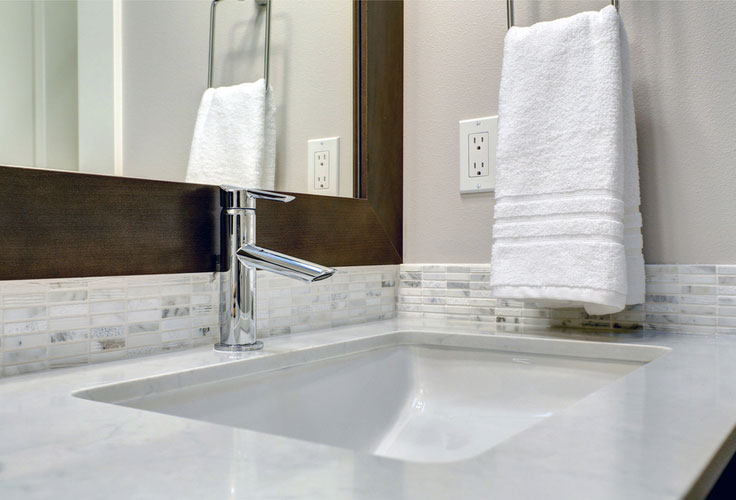Flat and beveled faucet washers are used to create a water-tight seal in faucets. Flat washers provide a stable seal, while beveled washers compensate for uneven surfaces.
Whether you’re dealing with a dripping faucet or undertaking a complete bathroom overhaul, understanding the difference between flat and beveled faucet washers is key to a successful plumbing project. The choice of washer affects not only the seal’s integrity but also the longevity of your faucet’s performance.
Each type of washer serves a distinct purpose in the realm of plumbing fixtures: flat washers offer a straightforward seal on flat surfaces, whereas beveled washers are designed to fit irregular or non-uniform surfaces. This insight is essential for both DIY enthusiasts and professional plumbers, ensuring that every connection is watertight and the installations stand the test of time. Let’s delve into the characteristics of flat versus beveled faucet washers to ensure your faucets are leak-free and functioning efficiently.

Credit: www.ebay.com
Flat And Beveled Faucet Washers: Unpacking The Basics
Under every faucet handle lies a small, yet significant piece: the washer. Choosing between flat and beveled washers can impact a faucet’s performance. Let’s delve into what makes these washers distinct and how they serve as the unsung heroes in controlling water flow.
The Role Of Washers In Faucet Mechanics
The washer in a faucet is a simple device. Its main job is to prevent leaks. When you turn off the tap, the washer seals the opening. This stops the water from dripping. Both flat and beveled washers play this role, but they fit differently.
- Stop Leaks: Seal tightly against water outlets.
- Durable Use: Reduce wear and tear in faucets.
- Save Water: Prevent wasteful dripping.
Physical Characteristics Of Flat And Beveled Washers
Washers come in different shapes. They fit specific faucet designs. Flat washers are smooth and level. They work well in faucets with a flat seat. Beveled washers have an angled edge. This helps them fit in faucets with a sloped seat.
| Type | Description | Best Used For |
|---|---|---|
| Flat Washers | Even surface, no angles. | Faucets with a flat valve seat. |
| Beveled Washers | Edge slanted at an angle. | Faucets with a sloped valve seat. |
Check the faucet design before choosing a washer. This ensures a snug fit. A properly selected washer means no drips and longer faucet life.

Credit: www.ebay.com
Analyzing The Performance Of Flat Faucet Washers
Flat faucet washers play a critical role in preventing leaks in plumbing fixtures. Unlike their beveled counterparts, these washers lie flush against surfaces, making their performance a topic worth exploring. This section delves into the effectiveness of flat faucet washers, examining how well they seal and their overall durability.
Sealing Capabilities Of Flat Washers
One key aspect of a washer’s job is to create a water-tight seal. Flat washers are designed to spread the sealing force evenly. This results in a reliable barrier against leaks. Factors affecting their performance include:
- Material quality: Higher grade materials enhance the seal.
- Surface contact: A complete flush fit prevents water from escaping.
- Installation precision: Proper placement ensures optimal performance.
Durability Concerns And Replacement Frequency
Longevity is vital for washers, as frequent replacements can be both inconvenient and costly. The durability of flat faucet washers hinges on:
| Material | Expected Lifespan |
|---|---|
| Rubber | 1-2 years |
| Neoprene | 3-5 years |
| Silicone | 5+ years |
Water conditions and usage frequency also influence washer wear. A regular check-up can help predict when replacements are due.
Beveled Washers: When And Why They Excel
In the diverse world of plumbing, the choice between flat and beveled faucet washers is crucial. Beveled washers stand out for their unique ability to handle specific situations better than their flat counterparts. This section uncovers the scenarios where beveled washers excel.
Advantages In High-pressure Applications
High-pressure environments pose a challenge for plumbing components. Beveled washers shine under pressure. Their angled design allows for a tighter seal, effectively containing water under forceful flow conditions. This characteristic makes beveled washers ideal for locations such as:
- Main water supply lines
- Industrial machines
- Irrigation systems
Compatibility With Non-uniform Surfaces
Diverse fittings and surfaces often face compatibility issues with flat washers. Beveled washers bridge this gap. The slanted edges contour easily, aligning perfectly with non-uniform surfaces. Achieving a tight seal becomes possible due to:
| Beveled Washer Feature | Benefit |
|---|---|
| Contoured Design | Conforms to irregular surfaces |
| Flexibility | Adjusts to surface imperfections |
Installation Intricacies For Optimal Function
Getting a faucet to work perfectly involves a small but crucial detail: the washer. A washer seals the gap, preventing leaks. The choice between flat and beveled washers matters. Each requires specific installation methods for the best performance.
Best Practices For Installing Flat Washers
Flat washers, with their even surfaces, pair well with flat-ended fixtures. Ensure a watertight seal by following some key steps:
- Check Compatibility: Match the washer to the faucet size and shape.
- Clean Surfaces: Remove old residue for a flush fit.
- Align Carefully: Place the washer evenly to avoid slippage.
- Tighten Gently: Secure the hardware without over-tightening to prevent damage.
Tips For Ensuring A Secure Fit With Beveled Washers
Beveled washers excel in angled or curved interfaces. Their slanted design helps in snug fits. Here’s how to install them right:
- Identify the Slope: Match the washer’s angle to the fixture’s slope.
- Insert Correctly: The thick edge should face the leakage point.
- Check Firmness: Ensure it’s snug, but not deformed.
- Test Functionality: Run water to check for any drips.
Maintenance And Troubleshooting Common Issues
Proper maintenance can ensure your faucets run smoothly. Sometimes, issues do arise with the washers inside your faucets. Knowing how to identify and fix these issues can save you time and money on costly repairs.
Identifying Signs Of Washer Failure
A washer is crucial for a leak-free faucet. It forms a tight seal preventing water from dripping. Wear and tear can lead to failure—a common plumbing issue.
- Dripping Faucet: Continuous dripping suggests washer damage.
- Irregular Water Flow: Stream changes hint at washer issues.
- Unusual Noises: Squeaks or chatter may signal washer wear.
Steps To Prolong Washer Life And Prevent Leaks
Extend the life of your faucet washers with these simple steps.
- Regular Checks: Inspect washers often for signs of wear.
- Gentle Use: Avoid over-tightening the faucet handles.
- Water Pressure Regulation: High pressure can damage washers.
- Clean Sediments: Flush out debris that can cause abrasion.
- Quality Replacements: Use high-grade washers for best performance.

Credit: www.amazon.com
Frequently Asked Questions For Flat Vs Beveled Faucet Washers Full Explanation
What Are Flat Faucet Washers?
Flat faucet washers are rubber or plastic discs that create a tight seal in compression faucets to prevent leaking.
Why Choose Beveled Faucet Washers?
Beveled faucet washers provide a better seal in fixtures with angled seats, enhancing leak prevention and washer durability.
Differences Between Flat And Beveled Washers?
Flat washers work best with flat surfaces, while beveled washers fit angled seats for improved sealing in plumbing fixtures.
How To Install Faucet Washers?
Turn off water supply, disassemble faucet handle, remove old washer, install new washer, reassemble tap, and turn on water to test.
Lifespan Of Faucet Washers?
The lifespan depends on material and water quality, but typically, faucet washers last between one to five years before replacement is needed.
Conclusion
Understanding the differences between flat and beveled faucet washers is key to ensuring a proper seal and preventing leaks. Whether you opt for flat washers for their versatility or beveled types for specific applications, your choice will contribute to the longevity of your faucet fixtures.
Remember, the right washer can make all the difference in your plumbing’s performance and maintenance.




Leave a Reply